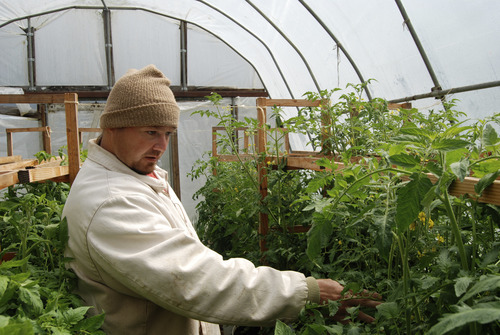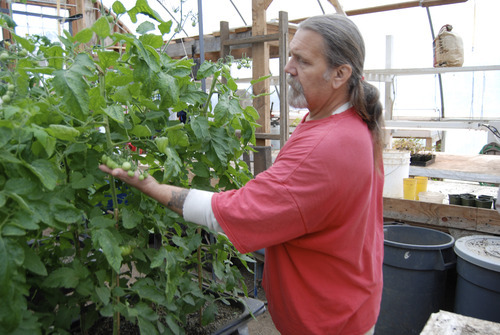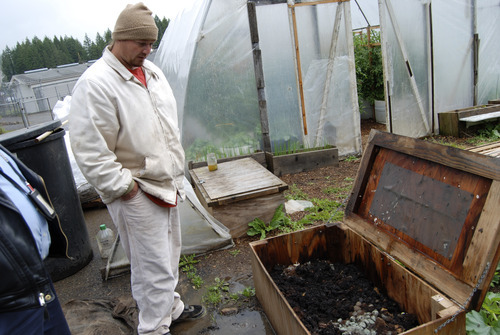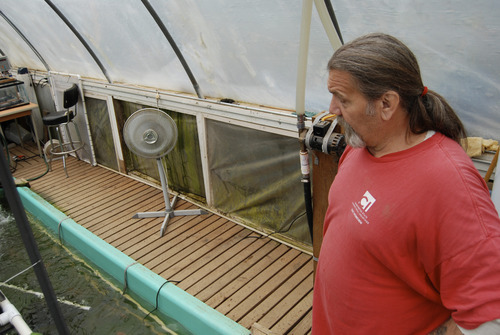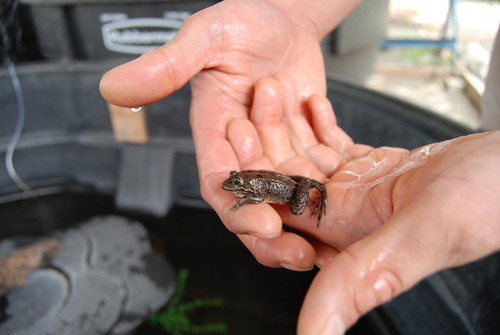This is an archived article that was published on sltrib.com in 2012, and information in the article may be outdated. It is provided only for personal research purposes and may not be reprinted.
Littlerock, Wash. • In a previous life, Taylor Davis boosted cars. But these days his focus is the health and welfare of 300 small amphibians.
He and Matt Henson, another inmate at Washington state's Cedar Creek Corrections Center, feed a captive research colony of Oregon spotted frogs three times a day, change their water and adjust the pH, look for signs of infection, grow the frogs' cricket meals, and monitor their growth.
This one-of-a-kind program enlisting prisoners in conservation is growing in scope and expanding into other parts of Washington. And other states are taking notice, according to Nalini Nadkarni, a one-time Evergreen, Wash., biologist who shaped the state's Sustainability in Prisons program after persuading officials to let her bring science to prisoners. Now at the University of Utah, Nadkarni is hoping to establish something similar at the Utah State Prison.
Nadkarni, one of the nation's most charismatic science ambassadors, moved to Utah last year to head the U.'s new Center for Science and Math Education. The Washington program was the subject of her recent TED talk, in which she described how connections to nature can mend social schisms and heal psychological wounds.
"If prisoners can grow plants and raise frogs, then perhaps there are other static entities that we hold inside ourselves, like greed, like addiction, like racism, that can also change," she said.
Oregon's spotted frog (Rana pretiosa) was once common in the warm marshy regions of the Pacific Northwest. Now a candidate for federal listing as an endangered species, the animal has been eliminated from about three-fourths of its range thanks to habitat loss and predation by invasive non-native bullfrogs. Washington wildlife officials intend to release Cedar Creek's captive-reared frogs in a research project conducted with Evergreen State College to better understand how to restore a creature that plays a vital role in the natural food chain.
Davis is proud of his operation's 80 percent survival rate, which is better than the Northwest's other captive rearing programs, typically at zoos.
"Ours grow bigger faster. We're the only facility that can raise them to maturity in less than a year. In nature it takes two to three years," he said.
The U.'s proposals to engage prisoners in ecological research face some cultural and institutional hurdles that aren't an issue in Washington, where prisons have a history with resource conservation, and sustainability is a policy goal across state government.
But Nadkarni expects to get her foot in the door with a science lecture series that will kick off at the Draper prison next month. The U. will host a national conference in January devoted to making prisons more sustainable. As for conservation research at the Utah prison, she is exploring the idea of growing native riparian flora that would be transplanted along the nearby Jordan River.
"It might not have the glamour of growing frogs, but it's a step in the right direction. I'm not discouraged at all. [Utah corrections chief] Tom Patterson has been courageous to invite us in for science lectures," Nadkarni said. "These kinds of relationships take time. I am happy to let it mature at its own pace."
Among the U. faculty interested in presenting their research to Utah prisoners are biologists David Carrier and Baldomero Olivera, and chemist Henry White.
Patterson declined to comment on the U. proposals because they are "extremely hypothetical" at this point.
"Department personnel are still in the middle of sorting through the information and working with the U. to see if there is evidence showing that this is something that is consistent with, and helps to further, Corrections' mission of protecting public safety and helping offenders to succeed," wrote spokesman Steve Gehrke in an email.
—
Prison as garden • Washington's Cedar Creek, a minimum-security 480-bed prison, is located on state forest lands in a wooded canyon outside the bucolic town of Littlerock, south of Olympia. A nature lover who wound up on the wrong side of the law would want to serve his time here. But inmates must earn their way to this institution, where many get to leave the secure compound to work on tree nurseries, tend bees, plant saplings, fight wildfires and perform other tasks related to Washington's rich natural resources.
It's a plum situation for an incarcerated felon, and few jeopardize the privilege by breaking the rules, according to superintendent Douglas Cole. Only well-behaved inmates with a release date within four years serve at Cedar Creek, which has not had a walk-away in almost three years.
Davis and Henson exit most days to look after the frogs, which live in tanks just outside the fence.
Although surrounded by a towering chain-link fence topped with razor wire, the grounds include carefully arranged flower and herb beds and other garden features that would make Martha Stewart herself feel at home — if Cedar Creek was not an all-male facility.
But Washington operates a similar women's center outside Aberdeen where inmates also grow gardens and engage in conservation research. Mission Creek Corrections Center inmates raise Taylor's checkerspot (Euphydryas editha taylori), an endangered butterfly.
Nadkarni, an expert in forest canopies, launched her conservation research at Cedar Creek a few years ago with inmates cultivating the silvery mosses that grow on tree trunks and have been harvested at alarming rates for floral arrangements. Now numerous inmate-staffed projects are under way at the prison, including Ed Stahl's "aquaponics" operation that combines tilapia aquaculture with a hydroponic vegetable garden.
In this experiment, wastewater from the fish-growing tank is cycled through the garden's gravel beds. The process not only decontaminates the water but boosts yields of peppers and tomatoes for the prison kitchen.
Up the hill, Robert Gibson uses worms to make nutritional gold. Inmates compost the prison's food waste, then transfer the muck into wooden boxes they call "worm farms." When sufficiently degraded, the compost is steeped in water to produce a rich tea-like liquid that feeds a productive vegetable garden. This stuff could sell for $5 a gallon, and Gibson brews 100 gallons at a time.
The prison superintendent said some inmates use their green skills when they look for jobs after being released.
"Even if they don't apply the trade they can apply the mind-set. They can take garbage and make something useful with it," Cole said. The compost operation processes about 400 yards of waste a year, cutting the prison's tipping fees by 75 percent when coupled with recycling initiatives.
In the frog operation, scientists harvest fertilized eggs from two sites, and the inmates rear them separately and insert tiny chips under the baggy folds of skin on the neck. In October, the current cohort of Cedar Creek frogs will be released in wetlands at a military base, and scientists will monitor them with wand readers that detect the chips. Then new batches of eggs will arrive at Cedar Creek.
Meanwhile, Davis is expanding the grow operation to include crickets as a way to reduce the frogs' grocery bill, which reaches $120 a week because of expensive crickets imported from Louisiana.
The pay might not be great and the hours are long, but the frog work is helping the former thief learn valuable habits and a new appreciation for life.
"It's giving a little back. When I was out I was taking a lot," Davis said. "Now I'm building a work ethic. You can't decide to not work. If you don't they'll die."


